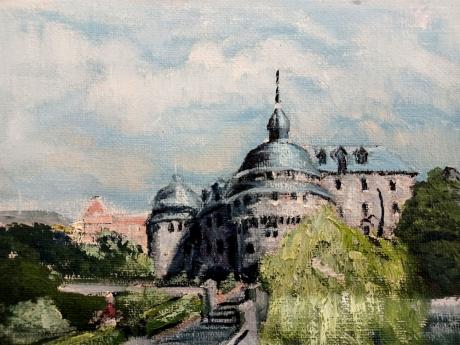" P Yates" and inscribed on the reverse
Örebro Castle (Swedish: Örebro slott) is a medieval castle fortification at Svartån in Örebro County, Sweden. It was expanded during the reign of the royal family Vasa (House of Vasa) and finally rebuilt about 1900. Some of the rooms are used as classrooms for pupils from Karolinska gymnasiet. The castle lies on an island in the river Svartån. The name of Örebro comes from the small stones ("ör") that the river transports. The second part of the word comes from the bridge ("bro") .
The oldest part of the castle, a defence tower, was erected in the latter half of the 13th century. It was probably built during the reign of King Magnus IV of Sweden (1316–1374). In 1364, Albrecht von Mecklenburg (ca 1340–1412) captured a fortress in Örebro. That was probably a predecessor of today's castle, which was built on the small island within the Svartå river. The fortress is supposed to have consisted of a defence tower with a surrounding wall.[2] The tower was added to in the 14th century to make a larger stronghold. Under King Charles IX of Sweden (1550–1611), the fortress was rebuilt into a Renaissance castle. Since 1764, the castle has served as the residence of the governor of Örebro County.
Örebro received its Royal Charter and city privileges not later than 1404. The name Örebro refers to a bridge (bro) crossing the river Svartån where the city is located. The prefix Öre- is derived from ör 'gravel (bank)'. The location became a natural seat of commerce in the Scandinavian Middle Ages and is mentioned in print in the 13th century. Old buildings from the early days include the foundations of the city church, a building which has undergone several modifications. The natural center of the city is otherwise Örebro Castle, situated on an islet in the Svartån, and dividing the town into a northern and a southern part. This castle was constructed during the stewardship of Birger Jarl during the late 13th century and then modified and enlarged during the reign of King Gustav Vasa in the 1560s. The Örebro Synod was held here in 1529.
Notable events in Örebro's history include the national diet meeting at Örebro in 1810, where Jean-Baptiste Bernadotte was elected crown prince of Sweden. Although a trade town, Örebro remained small until the second half of the 19th century, when it grew rapidly as a center of the national shoe-manufacturing industry (see: History of Närke).
Örebro is the hometown of the Swedish Chamber Orchestra and punk-rock band Millencolin. They named one of their albums Pennybridge Pioneers, where Pennybridge stands for Örebro as a colloquial translation into English.
Örebro is the hometown of various Swedish rock bands, such as Smash Into Pieces, Truckfighters, Blues Pills, Witchcraft, Troubled Horse and others, Graveyard's Lead Singer, Joakim Nilsson also was born in Örebro
The influential and highly popular grind band Nasum were formed in Örebro.
Örebro is one of the public broadcaster SVT's 12 local news districts and has television premises located in the city.
Örebro has hosted a contemporary art exhibition called Open Art on four occasions: in 2008, 2009, 2011 and 2013. In 2013, the exhibition featured works by 90 artists from Sweden and many other countries throughout the world. The fifth edition of the exhibition is planned for the summer of 2015.
Örebro University is one of Sweden's most recent, being upgraded from högskola (university college) in 1999. It currently has around 16,000 students and a staff of 1,100. The institution is regarded as one of the top 351–400 universities in the world. The university is also named among the world's top 100 young universities (number 62) in the 2018 THE Young University Rankings.
Gustavsvik, the largest water park in the Nordic countries, is located just a kilometer south of central Örebro. With more than 700,000 visitors per year, it is one of the most popular tourist and leisure establishments in Sweden. Only Liseberg, Gröna Lund and Skansen are more popular. In the summer the manor of Karlslund is a very popular place to visit.

